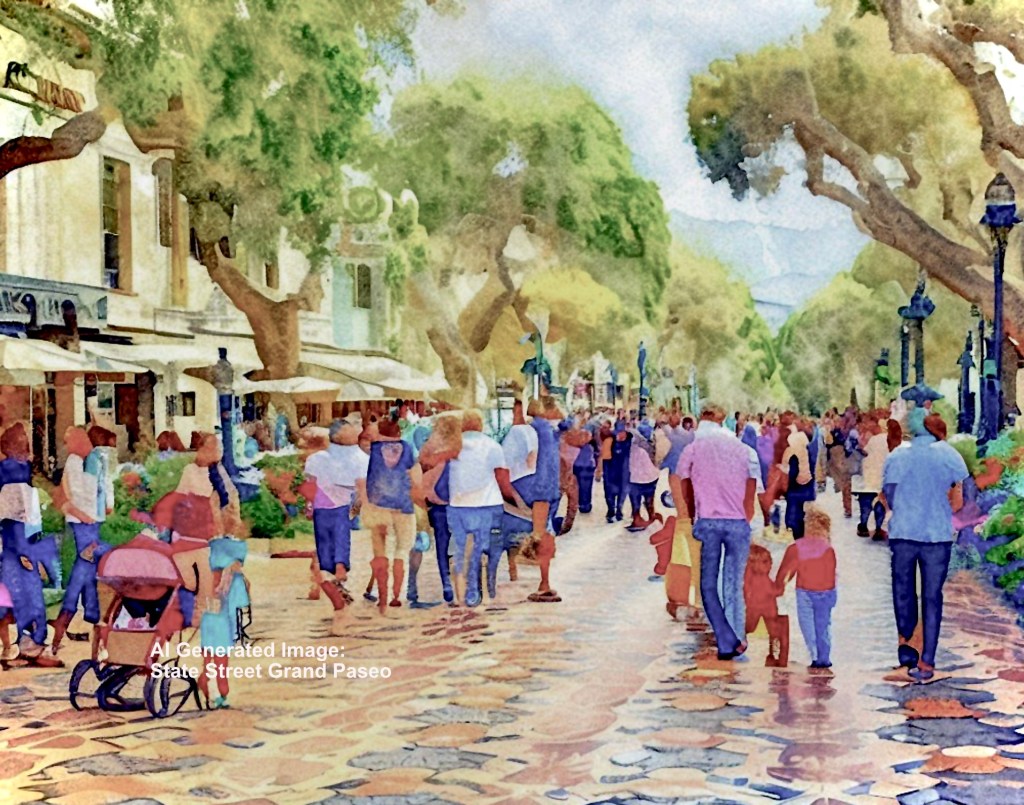The most successful cities of the future will be those that prioritize the health and happiness of their citizens above all else. This means designing cities that are walkable, bikeable, and transit-friendly, that prioritize green space and public gathering places, and that foster a sense of community and connection among residents. By doing so, we can create cities that are not only more sustainable, but also more livable and joyful.
Charles Montgomery, author, “Happy City”
Two of the most important initiatives that the City of Santa Barbara is currently undertaking are the development and implementation of the State Street Master Plan and the renewal of De la Guerra Plaza. These two projects will set the stage for the long-term sustainability and vitality of the heart of our beautiful city for the next hundred years.
Imagine a time in the future when State Street has been transformed into a Grand Paseo, an inclusive, car-free, park-like, pedestrian-oriented public space where people of all backgrounds and status can safely spend time with friends and families and all people young and old, can enjoy a sense of connection with one another and the community. A place where the community can thrive in a more livable, walkable, vital city. Cities great and small all over the world have successfully accomplished similar goals and so can Santa Barbara.
But pretty pictures and nicely delineated plans alone will not accomplish this grand vision. There are at least three fundamental elements vital for success. First, it is critical that we build strong community consensus to support the plan. We must keep our eyes on the visionary goals and not become distracted or overwhelmed by concerns about cost and technical challenges especially at this early stage of the process.
Which brings me to a second point, the need to create a nonprofit foundation to help pay for the extensive improvements needed to realize the plan and provide for the maintenance and the programming of activities that will be needed to sustain the vitality of the Grand Paseo and De la Guerra Plaza. In fact, such a foundation has already been created. Thanks to the foresight of architect Paul Rupp, the Friends of State Street charitable nonprofit foundation is already underway and raising money to support the Master Plan and all that is needed to bring it to fruition.
The third element needed is perhaps one of the most important in the long run: the creation of much more housing in the central business district. Developing homes close to jobs and services where people can walk to meet their daily needs without the need of a private automobile will ultimately ensure the long-term sustainability of downtown and contribute immeasurably to the goal of fighting climate change. It is critical for our city leaders to create policies that incentivize the creation of housing downtown to meet the full range of our housing needs. More people living downtown will ultimately support the long-term economic vitality of our downtown so that our local businesses can thrive far into the future.
In 2017 and again in 2020 during the height of the pandemic emergency, AIA Santa Barbara and most of its member architects joined with members of the community and stakeholders to convene a community design charrette focused on the future of the downtown State Street Corridor. Architects contributed, on a pro bono basis, their design skills to generate a vison for what a future car-free State Street Grand Paseo might look like. Hundreds of visionary ideas and concepts were generated by these talented and passionate architects, designers, and community stakeholders. They deserve our gratitude for their tireless commitment and caring for the well-being of the community.
Now it’s time for the entire community to come together to support this vison for our future. Soon the city and its consultant team will present the first master plan conceptual proposals. It’s critical that we engage as a community to provide constructive feedback to ensure that the plan ultimately meets our highest expectations and wishes. The outcome could well dictate the future of the community for the next hundred years.
Detlev Peikert is a member of the Board of Directors of AIASB.

